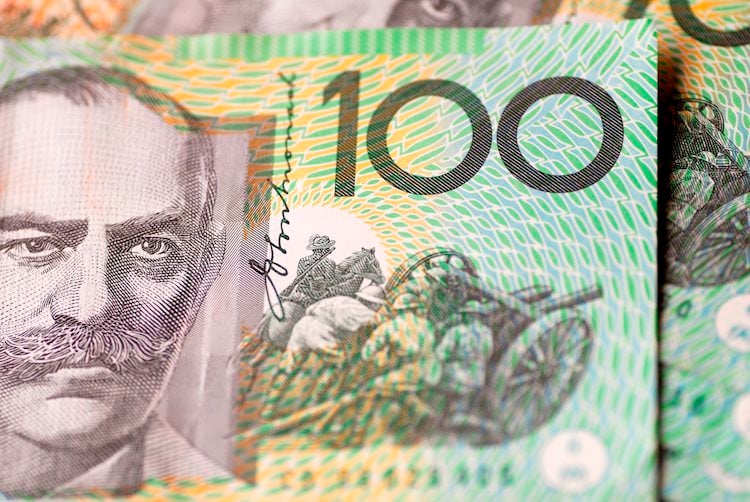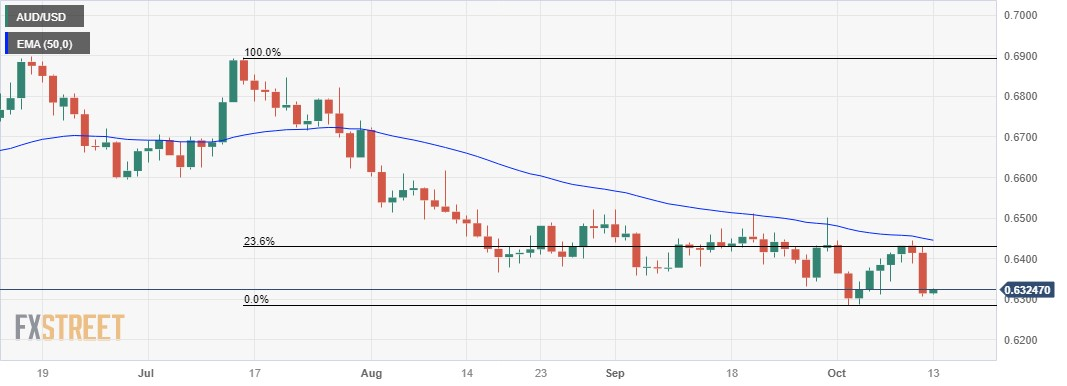- Australian Dollar dipped post-release of the US headline inflation.
- Consumer Inflation Expectations raised the odds of RBA to increase interest rates.
- US Dollar advanced following the slew of upbeat US data.
The Australian Dollar (AUD) attempts to retrace the recent losses, leaning towards the negative. This shift is attributed to the optimistic economic data from the United States (US) reported on Thursday. With US inflation surpassing expectations and initial jobless claims coming in lower than anticipated, discussions about the trajectory of the US Federal Reserve’s (Fed) monetary policy have been reignited.
Australia has experienced a rise in consumer expectations regarding inflation, a trend likely influenced by increased oil prices. The upcoming focal points include the release of Meeting Minutes from the Reserve Bank of Australia (RBA) and employment data in the next week.
The US Dollar Index (DXY) gained upward momentum after a robust release of US data. Nonetheless, on Friday, the US Dollar (USD) is trading marginally lower, influenced by a retreat in US Treasury yields following a recent surge. Market participants are expected to redirect their attention to the Michigan Consumer Sentiment Index set to be released on Friday.
Investors seem to factor in the possibility of another Fed rate hike. This is noteworthy given the recent dovish rhetoric from most Fed officials, emphasizing the necessity for the US central bank to maintain higher rates for an extended period, even without signaling a clear intention for another rate increase.
Daily Digest Market Movers: Australian Dollar attempts to retrace recent losses on RBA interest rates trajectory
-
Australian Consumer Inflation Expectations for October have been reported at 4.8% on Thursday, showing a slight increase from the September figure of 4.6%.
-
Australia witnessed a rebound in inflation in August, largely driven by elevated oil prices. This resurgence raises the probability of another interest rate hike by the Reserve Bank of Australia (RBA).
-
The unfolding Middle East conflict adds a layer of complexity to the situation, potentially prompting the RBA to implement a 25 basis points (bps) interest rate hike, reaching 4.35% by the year’s end.
-
The heightened geopolitical tension is fostering a surge in demand for commodities, particularly energy and gold. This surge is exerting a positive influence on the performance of the AUD/USD pair.
-
Australia’s Westpac Consumer Confidence showed that current buying conditions improved in October. The index rose 2.9% from the previous 1.5% decline in September.
-
The US Bureau of Labor Statistics (BLS) disclosed that the Consumer Price Index in the US surpassed forecasts in September. The annual basis figures expanded at a consistent rate of 3.7%, slightly exceeding estimates of 3.6%.
-
US Initial Jobless Claims for the week ending on October 6 showed a slight easing, despite an increase of 209K, which was slightly below the forecast of 210K.
-
US Producer Price Index (PPI) surged in September on a yearly basis, jumping from 2.0% to 2.2%, surpassing the anticipated 1.6%. Core PPI experienced a rise, climbing to 2.7% from the anticipated easing to 2.3%, surpassing the earlier figure of 2.5%.
-
The yields on US Treasury bonds advanced on Thursday on the back of solid US data, with the 10-year US Treasury bond yield marking the highest level at 4.72%.
-
The Federal Open Market Committee (FOMC) minutes shed light on a divergence of opinions, underlining the importance of data reliance. The consensus for additional interest rate hikes appears contingent on a significant uptick in inflation.
-
Some participants argue that as the policy rate approaches its peak, the focus should shift from the extent of rate increases to determining how long to maintain the policy rate at restrictive levels.
-
Market participants will likely monitor the US Michigan Consumer Sentiment Index on Friday. Although the Australian economic docket is empty on Friday, attention will shift to the Reserve Bank of Australia (RBA) meeting minutes and employment data scheduled for release in the coming week.
Technical Analysis: Australian Dollar holds ground above the major support level at 0.6300
The Australian Dollar trades around 0.6320, aligned to the major support level at 0.6300 lined up with a monthly low at 0.6285. The 23.6% Fibonacci retracement level at 0.6429 acts as strong resistance, followed by the 50-day Exponential Moving Average (EMA) at 0.6445 level. A clear breakthrough could pave the way for upward momentum, aiming at the psychological milestone of 0.6500.
AUD/USD: Daily Chart
Australian Dollar price today
The table below shows the percentage change of the Australian Dollar (AUD) against listed major currencies today. The Australian Dollar was the strongest against the US Dollar.
| USD | EUR | GBP | CAD | AUD | JPY | NZD | CHF | |
| USD | -0.04% | -0.08% | 0.00% | -0.05% | 0.01% | 0.00% | -0.06% | |
| EUR | 0.04% | -0.05% | 0.04% | -0.01% | 0.05% | 0.04% | -0.03% | |
| GBP | 0.07% | 0.04% | 0.08% | 0.03% | 0.09% | 0.08% | 0.02% | |
| CAD | 0.00% | -0.03% | -0.08% | -0.04% | 0.01% | 0.01% | -0.06% | |
| AUD | 0.06% | 0.01% | -0.04% | 0.05% | 0.06% | 0.06% | -0.01% | |
| JPY | -0.02% | -0.05% | -0.13% | -0.01% | -0.09% | -0.05% | -0.07% | |
| NZD | -0.02% | -0.02% | -0.08% | 0.01% | -0.05% | 0.03% | -0.06% | |
| CHF | 0.06% | 0.03% | -0.01% | 0.07% | 0.02% | 0.07% | 0.08% |
The heat map shows percentage changes of major currencies against each other. The base currency is picked from the left column, while the quote currency is picked from the top row. For example, if you pick the Euro from the left column and move along the horizontal line to the Japanese Yen, the percentage change displayed in the box will represent EUR (base)/JPY (quote).
Australian Dollar FAQs
One of the most significant factors for the Australian Dollar (AUD) is the level of interest rates set by the Reserve Bank of Australia (RBA). Because Australia is a resource-rich country another key driver is the price of its biggest export, Iron Ore. The health of the Chinese economy, its largest trading partner, is a factor, as well as inflation in Australia, its growth rate and Trade Balance. Market sentiment – whether investors are taking on more risky assets (risk-on) or seeking safe-havens (risk-off) – is also a factor, with risk-on positive for AUD.
The Reserve Bank of Australia (RBA) influences the Australian Dollar (AUD) by setting the level of interest rates that Australian banks can lend to each other. This influences the level of interest rates in the economy as a whole. The main goal of the RBA is to maintain a stable inflation rate of 2-3% by adjusting interest rates up or down. Relatively high interest rates compared to other major central banks support the AUD, and the opposite for relatively low. The RBA can also use quantitative easing and tightening to influence credit conditions, with the former AUD-negative and the latter AUD-positive.
China is Australia’s largest trading partner so the health of the Chinese economy is a major influence on the value of the Australian Dollar (AUD). When the Chinese economy is doing well it purchases more raw materials, goods and services from Australia, lifting demand for the AUD, and pushing up its value. The opposite is the case when the Chinese economy is not growing as fast as expected. Positive or negative surprises in Chinese growth data, therefore, often have a direct impact on the Australian Dollar and its pairs.
Iron Ore is Australia’s largest export, accounting for $118 billion a year according to data from 2021, with China as its primary destination. The price of Iron Ore, therefore, can be a driver of the Australian Dollar. Generally, if the price of Iron Ore rises, AUD also goes up, as aggregate demand for the currency increases. The opposite is the case if the price of Iron Ore falls. Higher Iron Ore prices also tend to result in a greater likelihood of a positive Trade Balance for Australia, which is also positive of the AUD.
The Trade Balance, which is the difference between what a country earns from its exports versus what it pays for its imports, is another factor that can influence the value of the Australian Dollar. If Australia produces highly sought after exports, then its currency will gain in value purely from the surplus demand created from foreign buyers seeking to purchase its exports versus what it spends to purchase imports. Therefore, a positive net Trade Balance strengthens the AUD, with the opposite effect if the Trade Balance is negative.

